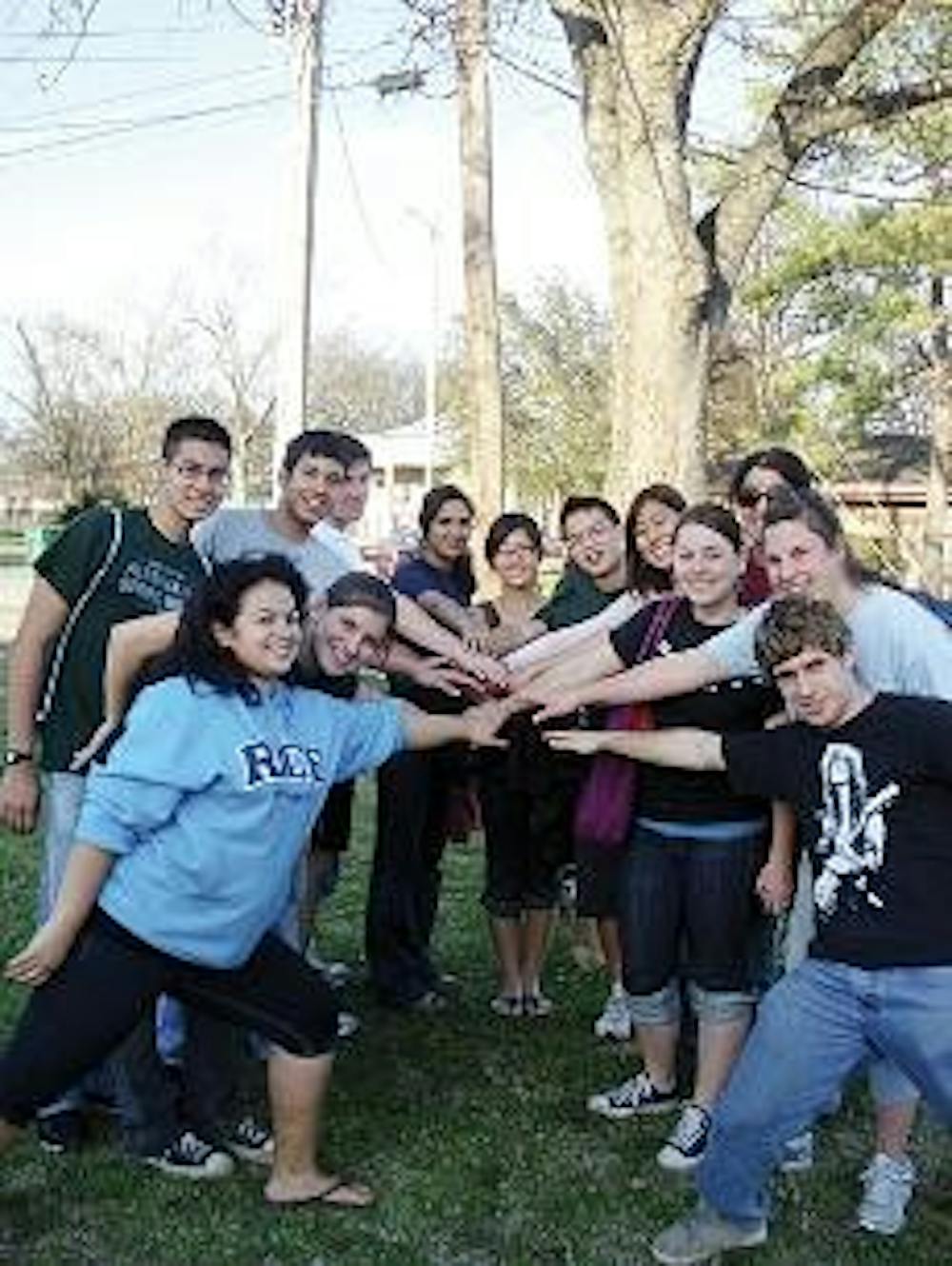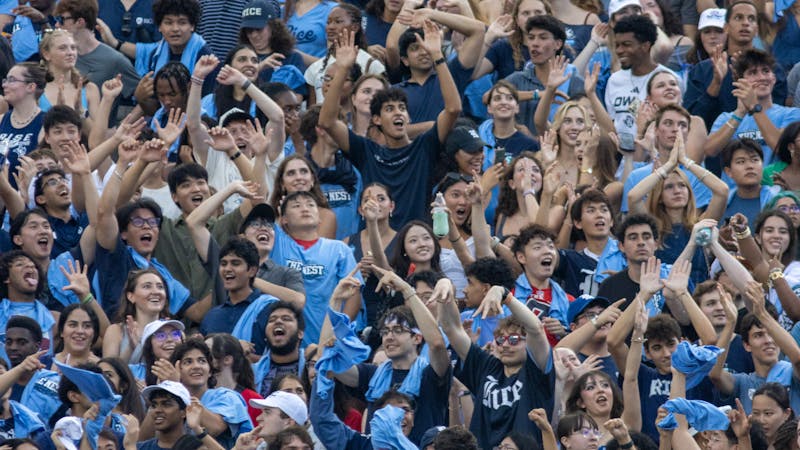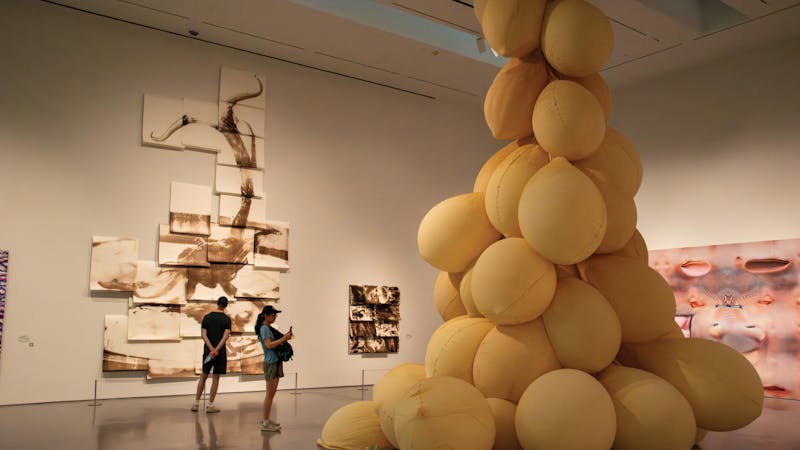Students devote spring break to serving others

The Mississippi Alternative Spring Break trip worked as Teach for America volunteers at a K-6 school in Moorhead, Miss.
Instead of basking in the tropical sun, over 100 students volunteered at various non-profit organizations throughout the country as part of Alternative Spring Break (ASB), which was sponsored by the Community Involvement Center. Eight groups of approximately 12 students worked in Colorado, Virginia, Mississippi, California, Washington, South Dakota, Illinois and Costa Rica, and one group of 40 volunteers visited Galveston. With an application pool twice the number of available spots, the selection process was highly competitive. Though participants were asked to pay a $250 registration fee, the rest of the money for the trips was raised by each team through special events and personal solicitations. Some groups chose to fundraise by holding a raffle for gift cards at nearby restaurants and stores, while others held bake sales or sold Valentine's goodies.
The ASB trips are organized mainly by students, ASB student coordinator Meg Goswami said. Though the Community Involvement Center chooses the site leaders, site leaders choose the location, the non-profit organization they wish to work with, the issue they want to address and their own team of volunteers.
"The CIC, as the sponsor, gives advice and help to the site leaders, but the site leaders do most of the planning," Goswami, a Baker College senior, said.
Santa Cruz, California
For the third year in a row, the Rice Environmental Club worked with the YMCA of the Redwoods volunteering as cabin leaders at Camp Campbell Outdoor Science School, located in California's Santa Cruz Mountains. Through classroom activities on the water cycle, predator-prey relationships and daily hikes through the forest, Rice volunteers helped cultivate Campbell students' interest in nature and helped develop their knowledge and awareness of environmentally-friendly practices.
A majority of the fifth graders at the school come from the inner city and might not otherwise have any exposure to nature and ecology, Wiess College sophomore Jacob Pflug said. Pflug said a majority of the Rice volunteers learned more about how socioeconomic status affects children through their interactions with the students.
"The kids not only learned about the outdoors and science but also on a social context of how to interact with each other and behave," he said. "We were in constant contact with people we were helping. I found it was very touching to receive feedback from them."
Denver, Colorado
In Denver, Colo., volunteers worked at the Colorado Center for the Blind, a school that teaches blind people how to perform everyday tasks in order to become more independent. Volunteers shadowed students, who ranged in age from 18 to 65, and at times wore blindfolds in order to learn what it was like to be without sight, Baker junior Lauren Krenek said.
"Not being able to see makes many things more difficult, but it's not impossible to move on, and I'm glad that we were able to help others in that process," Krenek said.
One of the classes taught at the school is traveling, in which students are taught to navigate outside using different techniques, Wiess College sophomore Courtney Souza said.
"One of the instructors asked me when I was blindfolded if I felt the wind on my right, and when I said no, she said that's because there's a tree to your right," Souza said.
Students at the Colorado Center are also taught to use the sun to tell the time of the day and to tell the directions. By hearing different types of sounds when tapping their canes, students can also tell if a building is nearby.
The volunteers also helped children with Epidermolysis Bullosa from the National Sports Center for the Disabled to ski down snowy slopes. Children with this disease have very fragile skin, making it necessary for them to sit in a sleigh-like car with a volunteer holding the reins on the back for steering support. The ASB volunteers skied with children ranging in ages from 10 to 15.
Lorton, Virginia
A group stationed at Lorton, Va., worked at the Mason Neck State Park to create 788 feet of trail in a park that protects bald eagles. According to site coordinator David Ouyang, participants chose Lorton because they wanted to protect bald eagles.
"[They] are a symbol of our national heritage, and conservation is about preserving our national heritage," Ouyang, a Baker junior said. "We will also donate the surplus money from our trip to the state park."
Moorhead, Mississippi
Further south, students volunteered with Teach for America in Moorhead, Miss. The students worked with children, 95 percent of whom came from single-parent families living below the poverty line.
Site leader Brendan Hayes tutored a fourth grader who told him, "You are the best friend I ever had," Hayes said. Hayes, a Sid Richardson College sophomore, was one of 13 students who volunteered in the Mississippi Delta at Sunflower Elementary and Rosser Elementary. According to Hayes, the children are at least a grade level lower in their education, but knew the importance of education and were eager to learn.
The facilities in the two schools included two classrooms per grade and one computer per classroom. Because the value of land in Moorhead is one of the lowest in America, the property tax used for funding education initiatives is minimal, Hayes said. This condition often fails to attract quality teachers to the two elementary schools, and there is an approximate 1-to-1 ratio of paid teachers to TFA volunteers working at the schools.
Volunteers focused on helping the children prepare for their state exams. One Rice student was assigned to each class from kindergarten through sixth grade.
"We had a huge presence at the schools," Will Rice sophomore and site leader Marisol Alvarado said. "At lunch all of the kids wanted to sit with us because we were part of their family."
As part of a beautification project, the Rice students also planted numerous trees outside of Rosser Elementary.
Alvarado said she found the experience inspiring.
"Humanity is one continuous spectrum," Alvarado said. "They are only differing in their situation, only by chance."
Cedro-Wooley, Washington
On the trip to Cedro-Wooley, Wash., students had to deal with the rainy Pacific Northwest winter. The participants spent four days clearing brush from a vacant lot in preparation for a Habitat for Humanity house. In addition, they built "good-neighbor" wooden fences and volunteered their time at a soup kitchen, repainting the walls of the much-used building.
Site members said they felt welcomed into the area.
"The most surprising thing was probably how friendly a small-town community was towards us," Brown College sophomore Abraham Segura said. "They pretty much opened their arms to us. As soon as we arrived they provided us with almost everything... they didn't have much to give, but they still gave us what they could."
Eagle Butte, South Dakota
Those who went to South Dakota were working in familiar territory, as a Rice ASB trip had visited Eagle Butte, S.D., last year as well. The students assisted the Sioux with the Cheyenne River Youth Project, working in the youth center with the children of the small town.
Chicago, Illinois
Rivaling those in South Dakota for coldest trip, a group of students traveled to Chicago to do work in the homeless community and with the Boys and Girls Clubs of America. The students were able to volunteer at the Inspiration Corporation, an organization that caters to those in the homeless community who hope to get back on their feet. In order to be served at the Inspiration Cafe, homeless patrons need to apply and bring in at least one reference. Once accepted, the homeless clientele receive free meals in a cafe setup, complete with menus and waiters.
"The one thing I got out of my trip was a better understanding of how volunteer organization can help people in struggling communities, and how I want to make a difference when I graduate," Brown senior Akshay Dayal said.
Galveston, Texas
Closer to home, about 40 students, as part of the largest ASB group this year, spent five days helping with Hurricane Ike relief efforts in Galveston. Six months after the hurricane, many homes were still in dire need of repair, site leader Nicole Kwan, a Baker sophomore, said. The team, co-sponsored by the Baptist Student Ministry, paired up with an organization called Good News Galveston. Daily assignments included gutting out water-damaged homes by taking off dry wall and wood panels and painting homes of Good News Glaveston clients who lived near the center. Kwan said several groups also ventured farther to St. Leon fishing village to clear debris, and a few volunteers went to the old food bank on the mainland to clean and repaint boxes used for medical supplies.
Costa Rica
Outside of the country, volunteers lived with the second largest tribe in Costa Rica in rural mountainous villages. Volunteers participated in a nine-year-old project, the Kan Tan Project, pioneered by a family within the tribe who wished to promote and preserve the ecosystem and the tribe's indigenous culture.
Although the village is remote and removed from the direct influence of modern culture, elder Kan Tan are afraid of losing their native culture. Hints of modernization were obvious amongst the younger generation as they listened to songs by Ludacris, Martel College sophomore Kara Calhoun said.
"The young people are really aware of their [indigenous] culture but are more conflicted," Calhoun said. "They want to leave but they don't have the means."
Volunteers helped to preserve indigenous traditions such as cooking over a fire and carving tribal masks. They also helped build pit latrines and re-roofed the kitchen of the cultural center of the indigenous Kan Tan tribe.
A whole week without the conveniences of modern technology gave volunteers a new perspective, Calhoun said.
"We were taught to appreciate what we had so much more," she said. "They are satisfied with the little they have."
Casey Michel and Cindy Dinh contributed to this article.
More from The Rice Thresher

Rice loses to UH in Bayou Bucket Classic
The Bayou Bucket will remain with the University of Houston until at least 2030 after Rice football lost to the Cougars Saturday.

Moody Center’s new exhibit blurs the line between body and machine
Swelling latex sculptures, inspired by placentas and umbilical cords have taken up residence in the Moody Center for the Arts. The Barcelona-based artist Eva Fàbregas describes her pieces as forms that grow from “the guts of the architecture,” inflating and wrinkling as if they were alive.

Fizz users and moderators talk fame, challenges
During the volleyball team’s face-off against the University of Texas at Austin on Sept. 3, Jack Vu decided to have a little fun with the scoreboard. An anonymous poster had inaccurately mentioned that Rice beat UT on Fizz, so Vu decided to join in.

Please note All comments are eligible for publication by The Rice Thresher.